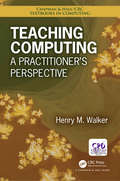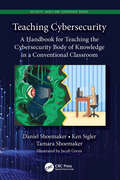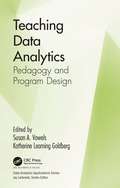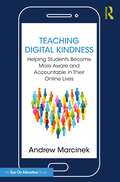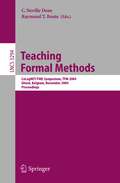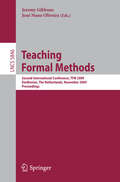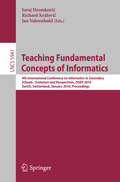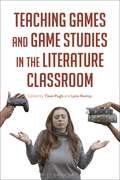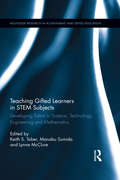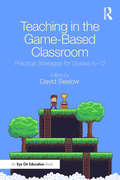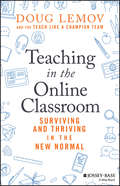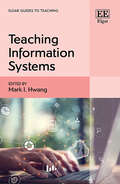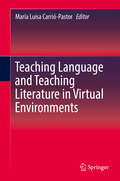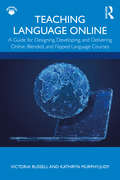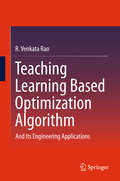- Table View
- List View
Teaching Computing: A Practitioner's Perspective
by Henry M. WalkerTeaching can be intimidating for beginning faculty. Some graduate schools and some computing faculty provide guidance and mentoring, but many do not. Often, a new faculty member is assigned to teach a course, with little guidance, input, or feedback. Teaching Computing: A Practitioner’s Perspective addresses such challenges by providing a solid resource for both new and experienced computing faculty. The book serves as a practical, easy-to-use resource, covering a wide range of topics in a collection of focused down-to-earth chapters. Based on the authors’ extensive teaching experience and his teaching-oriented columns that span 20 years, and informed by computing-education research, the book provides numerous elements that are designed to connect with teaching practitioners, including: A wide range of teaching topics and basic elements of teaching, including tips and techniques Practical tone; the book serves as a down-to-earth practitioners’ guide Short, focused chapters Coherent and convenient organization Mix of general educational perspectives and computing-specific elements Connections between teaching in general and teaching computing Both historical and contemporary perspectives This book presents practical approaches, tips, and techniques that provide a strong starting place for new computing faculty and perspectives for reflection by seasoned faculty wishing to freshen their own teaching.
Teaching Computing: A Practitioner's Perspective
by Henry M. WalkerTeaching can be intimidating for beginning faculty. Some graduate schools and some computing faculty provide guidance and mentoring, but many do not. Often, a new faculty member is assigned to teach a course, with little guidance, input, or feedback. Teaching Computing: A Practitioner’s Perspective addresses such challenges by providing a solid resource for both new and experienced computing faculty. The book serves as a practical, easy-to-use resource, covering a wide range of topics in a collection of focused down-to-earth chapters. Based on the authors’ extensive teaching experience and his teaching-oriented columns that span 20 years, and informed by computing-education research, the book provides numerous elements that are designed to connect with teaching practitioners, including: A wide range of teaching topics and basic elements of teaching, including tips and techniques Practical tone; the book serves as a down-to-earth practitioners’ guide Short, focused chapters Coherent and convenient organization Mix of general educational perspectives and computing-specific elements Connections between teaching in general and teaching computing Both historical and contemporary perspectives This book presents practical approaches, tips, and techniques that provide a strong starting place for new computing faculty and perspectives for reflection by seasoned faculty wishing to freshen their own teaching.
Teaching Cybersecurity: A Handbook for Teaching the Cybersecurity Body of Knowledge in a Conventional Classroom (Security, Audit and Leadership Series)
by Daniel Shoemaker Ken Sigler Tamara ShoemakerLet’s be realistic here. Ordinary K-12 educators don’t know what "cybersecurity" is and could probably care less about incorporating it into their lesson plans. Yet, teaching cybersecurity is a critical national priority. So, this book aims to cut through the usual roadblocks of confusing technical jargon and industry stovepipes and give you, the classroom teacher, a unified understanding of what must be taught. That advice is based on a single authoritative definition of the field. In 2017, the three societies that write the standards for computing, software engineering, and information systems came together to define a single model of the field of cybersecurity. It is based on eight building blocks. That definition is presented here. However, we also understand that secondary school teachers are not experts in arcane subjects like software, component, human, or societal security. Therefore, this book explains cybersecurity through a simple story rather than diving into execution details. Tom, a high school teacher, and Lucy, a middle school teacher, are tasked by their district to develop a cybersecurity course for students in their respective schools. They are aided in this by "the Doc," an odd fellow but an expert in the field. Together they work their way through the content of each topic area, helping each other to understand what the student at each level in the educational process has to learn. The explanations are simple, easy to understand, and geared toward the teaching aspect rather than the actual performance of cybersecurity work. Each chapter is a self-contained explanation of the cybersecurity content in that area geared to teaching both middle and high school audiences. The eight component areas are standalone in that they can be taught separately. But the real value lies in the comprehensive but easy-to-understand picture that the reader will get of a complicated field.
Teaching Cybersecurity: A Handbook for Teaching the Cybersecurity Body of Knowledge in a Conventional Classroom (Security, Audit and Leadership Series)
by Daniel Shoemaker Ken Sigler Tamara ShoemakerLet’s be realistic here. Ordinary K-12 educators don’t know what "cybersecurity" is and could probably care less about incorporating it into their lesson plans. Yet, teaching cybersecurity is a critical national priority. So, this book aims to cut through the usual roadblocks of confusing technical jargon and industry stovepipes and give you, the classroom teacher, a unified understanding of what must be taught. That advice is based on a single authoritative definition of the field. In 2017, the three societies that write the standards for computing, software engineering, and information systems came together to define a single model of the field of cybersecurity. It is based on eight building blocks. That definition is presented here. However, we also understand that secondary school teachers are not experts in arcane subjects like software, component, human, or societal security. Therefore, this book explains cybersecurity through a simple story rather than diving into execution details. Tom, a high school teacher, and Lucy, a middle school teacher, are tasked by their district to develop a cybersecurity course for students in their respective schools. They are aided in this by "the Doc," an odd fellow but an expert in the field. Together they work their way through the content of each topic area, helping each other to understand what the student at each level in the educational process has to learn. The explanations are simple, easy to understand, and geared toward the teaching aspect rather than the actual performance of cybersecurity work. Each chapter is a self-contained explanation of the cybersecurity content in that area geared to teaching both middle and high school audiences. The eight component areas are standalone in that they can be taught separately. But the real value lies in the comprehensive but easy-to-understand picture that the reader will get of a complicated field.
Teaching Data Analytics: Pedagogy and Program Design (Data Analytics Applications)
by Susan A Vowels Katherine Leaming GoldbergThe need for analytics skills is a source of the burgeoning growth in the number of analytics and decision science programs in higher education developed to feed the need for capable employees in this area. The very size and continuing growth of this need means that there is still space for new program development. Schools wishing to pursue business analytics programs intentionally assess the maturity level of their programs and take steps to close the gap. Teaching Data Analytics: Pedagogy and Program Design is a reference for faculty and administrators seeking direction about adding or enhancing analytics offerings at their institutions. It provides guidance by examining best practices from the perspectives of faculty and practitioners. By emphasizing the connection of data analytics to organizational success, it reviews the position of analytics and decision science programs in higher education, and to review the critical connection between this area of study and career opportunities. The book features: A variety of perspectives ranging from the scholarly theoretical to the practitioner applied An in-depth look into a wide breadth of skills from closely technology-focused to robustly soft human connection skills Resources for existing faculty to acquire and maintain additional analytics-relevant skills that can enrich their current course offerings. Acknowledging the dichotomy between data analytics and data science, this book emphasizes data analytics rather than data science, although the book does touch upon the data science realm. Starting with industry perspectives, the book covers the applied world of data analytics, covering necessary skills and applications, as well as developing compelling visualizations. It then dives into pedagogical and program design approaches in data analytics education and concludes with ideas for program design tactics. This reference is a launching point for discussions about how to connect industry’s need for skilled data analysts to higher education’s need to design a rigorous curriculum that promotes student critical thinking, communication, and ethical skills. It also provides insight into adding new elements to existing data analytics courses and for taking the next step in adding data analytics offerings, whether it be incorporating additional analytics assignments into existing courses, offering one course designed for undergraduates, or an integrated program designed for graduate students.
Teaching Data Analytics: Pedagogy and Program Design (Data Analytics Applications)
by Susan A Vowels Katherine Leaming GoldbergThe need for analytics skills is a source of the burgeoning growth in the number of analytics and decision science programs in higher education developed to feed the need for capable employees in this area. The very size and continuing growth of this need means that there is still space for new program development. Schools wishing to pursue business analytics programs intentionally assess the maturity level of their programs and take steps to close the gap. Teaching Data Analytics: Pedagogy and Program Design is a reference for faculty and administrators seeking direction about adding or enhancing analytics offerings at their institutions. It provides guidance by examining best practices from the perspectives of faculty and practitioners. By emphasizing the connection of data analytics to organizational success, it reviews the position of analytics and decision science programs in higher education, and to review the critical connection between this area of study and career opportunities. The book features: A variety of perspectives ranging from the scholarly theoretical to the practitioner applied An in-depth look into a wide breadth of skills from closely technology-focused to robustly soft human connection skills Resources for existing faculty to acquire and maintain additional analytics-relevant skills that can enrich their current course offerings. Acknowledging the dichotomy between data analytics and data science, this book emphasizes data analytics rather than data science, although the book does touch upon the data science realm. Starting with industry perspectives, the book covers the applied world of data analytics, covering necessary skills and applications, as well as developing compelling visualizations. It then dives into pedagogical and program design approaches in data analytics education and concludes with ideas for program design tactics. This reference is a launching point for discussions about how to connect industry’s need for skilled data analysts to higher education’s need to design a rigorous curriculum that promotes student critical thinking, communication, and ethical skills. It also provides insight into adding new elements to existing data analytics courses and for taking the next step in adding data analytics offerings, whether it be incorporating additional analytics assignments into existing courses, offering one course designed for undergraduates, or an integrated program designed for graduate students.
Teaching Digital Kindness: Helping Students Become More Aware and Accountable in Their Online Lives
by Andrew MarcinekDigital tools have a clear educational purpose, but how do we help students with the darker corners of the web? This book provides timely, much-needed advice for educators on how to teach students to handle the anger and divisiveness that pervades social media and that is impossible to ignore when using tech for other purposes. Author Andrew Marcinek provides strategies we can use to help students with issues such as navigating relationships; understanding digital ethics and norms; returning to a balance with screen time; reclaiming conversation; holding yourself accountable; creating a new digital mindset; and more. Throughout, there are practical features such as Pause and Reflects, Teachable Moments, and classroom activities and lesson plans, so you can easily implement the ideas across content areas and grade levels.
Teaching Digital Kindness: Helping Students Become More Aware and Accountable in Their Online Lives
by Andrew MarcinekDigital tools have a clear educational purpose, but how do we help students with the darker corners of the web? This book provides timely, much-needed advice for educators on how to teach students to handle the anger and divisiveness that pervades social media and that is impossible to ignore when using tech for other purposes. Author Andrew Marcinek provides strategies we can use to help students with issues such as navigating relationships; understanding digital ethics and norms; returning to a balance with screen time; reclaiming conversation; holding yourself accountable; creating a new digital mindset; and more. Throughout, there are practical features such as Pause and Reflects, Teachable Moments, and classroom activities and lesson plans, so you can easily implement the ideas across content areas and grade levels.
Teaching Formal Methods: CoLogNET/FME Symposium, TFM 2004, Ghent, Belgium, November 18-19, 2004. Proceedings (Lecture Notes in Computer Science #3294)
by C. Neville Dean Raymond T. Boute“Professional engineers can often be distinguished from other designers by the engineers’ ability to use mathematical models to describe and 1 analyze their products.” This observation by Parnas describes the de facto professional standards in all classical engineering disciplines (civil, mechanical, electrical, etc.). Unf- tunately, it is in sharp contrast with current (industrial) practice in software design, where mathematical models are hardly used at all, even by those who, 2 in Holloway’s words “aspire to be engineers.” The rare exceptions are certain critical applications, where mathematical techniques are used under the general name formal methods. Yet,thesamecharacteristicsthatmakeformalmethodsanecessityincritical applicationsmakethemalsoadvantageousineverydaysoftwaredesignatvarious levels from design e?ciency to software quality. Why, then, is education failing with respect to formal methods? – failing to convince students, academics and practitioners alike that formal methods are truly pragmatic; – failing to overcome a phobia of formality and mathematics; – failing to provide students with the basic skills and understanding required toadoptamoremathematicalandlogicalapproachtosoftwaredevelopment. Until education takes these failings seriously, formal methods will be an obscure byway in software engineering, which in turn will remain severely impoverished as a result.
Teaching Formal Methods: Second International Conference, TFM 2009, Eindhoven, The Netherlands, November 2-6, 2009, Proceedings (Lecture Notes in Computer Science #5846)
by Jeremy Gibbons Jose Nuno OliveiraThis volume contains the proceedings of TFM2009, the Second International FME Conference on Teaching Formal Methods, organized by the Subgroup of Education of the Formal Methods Europe (FME) association. The conference took place as part of the ?rst Formal Methods Week (FMWeek), held in Ei- hoven, The Netherlands, in November 2009. TFM2009 was a one-day forum in which to explore the successes and fa- ures of formal method (FM) education, and to promote cooperative projects to further educationand training in FMs. The organizersgatheredlecturers,tea- ers,andindustrialpartnersto discusstheir experience,presenttheir pedagogical methodologies, and explore best practices. Interest in FM teaching is growing. TFM2009 followed in a series of events on teaching FMs which includes two BCS-FACS TFM workshops (Oxford in 2003, and London in 2006), the TFM2004 conference (Ghent, 2004, with p- ceedings published as Springer LNCS Volume 3294), the FM-Ed 2006 workshop (Hamilton, co-located with FM2006), FORMED (Budapest, at ETAPS2008), and FMET2008 (Kitakyushu, co-located with ICFEM2008). FMs have an important role to play in the development of complex c- puting systems—a role acknowledged in industrial standards such as IEC61508 and ISO/IEC15408, and in the increasing use of precise modelling notations, semantic markup languages, and model-driven techniques. There is a growing need for software engineers who can work e?ectively with simple, mathematical abstractions, and with practical notions of inference and proof.
Teaching Fundamental Concepts of Informatics: 4th International Conference on Informatics in Secondary Schools - Evolution and Perspectives, ISSEP 2010, Zurich, Switzerland, January 13-15, 2010, Proceedings (Lecture Notes in Computer Science #5941)
by Juraj Hromkovi 269 Rastislav Královic Jan VahrenholdThe International Conference on Informatics in Secondary Schools: Evolution and Perspective (ISSEP) is an emerging forum for researchers and practitioners in the area of computer science education with a focus on secondary schools. The ISSEP series started in 2005 in Klagenfurt, and continued in 2006 in Vilnius, and in 2008 in Torun. ´ The 4th ISSEP took part in Zurich. This volume presents 4 of the 5 invited talks and 14 regular contributions chosen from 32 submissions to ISSEP 2010. The ISSEP conference series is devoted to all aspects of computer science teaching. In the preface of the proceedings of ISSEP 2006, Roland Mittermeir wrote: “ISSEP aims at educating ‘informatics proper’ by showing the beauty of the discipline, hoping to create interest in a later professional career in c- puting, and it will give answers di?erent from the opinion of those who used to familiarize pupils with the basics of ICT in order to achieve computer lit- acy for the young generation. ” This is an important message at this time, when several countries have reduced teaching informatics to educating about current softwarepackagesthatchangefromyeartoyear. ThegoalofISSEPistosupport teaching of the basic concepts and methods of informatics, thereby making it a subject in secondary schools that is comparable in depth and requirements with mathematics or natural sciences. As we tried to present in our book “Algori- mic Adventures.
Teaching Games and Game Studies in the Literature Classroom
by Tison Pugh and Lynn RameyTeaching Games and Game Studies in the Literature Classroom offers practical suggestions for educators looking to incorporate ludic media, ranging from novels to video games and from poems to board games, into their curricula. Across the globe, video games and interactive media have already been granted their own departments at numerous larger institutions and will increasingly fall under the purview of language and literature departments at smaller schools. This volume considers fundamental ways in which literature can be construed as a game and the benefits of such an approach. The contributors outline pedagogical strategies for integrating the study of video games with the study of literature and consider the intersections of identity and ideology as they relate to literature and ludology. They also address the benefits (and liabilities) of making the process of learning itself a game, an approach that is quickly gaining currency and increasing interest. Every chapter is grounded in theory but focuses on practical applications to develop students' critical thinking skills and intercultural competence through both digital and analog gameful approaches.
Teaching Games and Game Studies in the Literature Classroom
Teaching Games and Game Studies in the Literature Classroom offers practical suggestions for educators looking to incorporate ludic media, ranging from novels to video games and from poems to board games, into their curricula. Across the globe, video games and interactive media have already been granted their own departments at numerous larger institutions and will increasingly fall under the purview of language and literature departments at smaller schools. This volume considers fundamental ways in which literature can be construed as a game and the benefits of such an approach. The contributors outline pedagogical strategies for integrating the study of video games with the study of literature and consider the intersections of identity and ideology as they relate to literature and ludology. They also address the benefits (and liabilities) of making the process of learning itself a game, an approach that is quickly gaining currency and increasing interest. Every chapter is grounded in theory but focuses on practical applications to develop students' critical thinking skills and intercultural competence through both digital and analog gameful approaches.
Teaching Gifted Learners in STEM Subjects: Developing Talent in Science, Technology, Engineering and Mathematics (Routledge Research in Achievement and Gifted Education)
by Keith S. Taber Manabu Sumida Lynne McClureThis book offers an overview of programmes designed to support the learning of gifted and talented students in STEM subjects, both to allow them to meet their potential and to encourage them to proceed towards careers in STEM areas. The chapters from a range of national contexts report on perspectives, approaches and projects in gifted education in STEM subjects. These contributions provide a picture of the state of research and practice in this area, both to inform further research and development, and to support classroom teachers in their day-to-day work. Chapters have been written with practitioners in mind, but include relevant scholarly citations to the literature. The book includes some contributions illustrating research and practice in specific STEM areas, and others which bridge across different STEM subjects. The volume also includes an introductory theoretical chapter exploring the implications for gifted learners of how 'STEM' is understood and organized within the school curriculums.
Teaching Gifted Learners in STEM Subjects: Developing Talent in Science, Technology, Engineering and Mathematics (Routledge Research in Achievement and Gifted Education)
by Keith S. Taber Manabu Sumida Lynne McClureThis book offers an overview of programmes designed to support the learning of gifted and talented students in STEM subjects, both to allow them to meet their potential and to encourage them to proceed towards careers in STEM areas. The chapters from a range of national contexts report on perspectives, approaches and projects in gifted education in STEM subjects. These contributions provide a picture of the state of research and practice in this area, both to inform further research and development, and to support classroom teachers in their day-to-day work. Chapters have been written with practitioners in mind, but include relevant scholarly citations to the literature. The book includes some contributions illustrating research and practice in specific STEM areas, and others which bridge across different STEM subjects. The volume also includes an introductory theoretical chapter exploring the implications for gifted learners of how 'STEM' is understood and organized within the school curriculums.
Teaching in the Game-Based Classroom: Practical Strategies for Grades 6-12
by David SeelowTeaching in the Game-Based Classroom is a hands-on guide to leveraging students’ embrace of video games toward successful school performance. Evidence tells us that game-based learning can help teachers design classes, develop transformative learning tools, and assess progress on multiple levels not dependent on one-size-fits-all bubble sheets. Authored by game-savvy teachers in partnership with classroom-experienced academics, the highly varied chapters of this book are concise yet filled with sound pedagogical approaches. Middle and high school educators will find engaging new ways of inspiring students’ intrinsic motivation, skill refinement, positive culture-building, autonomy as learners, and more.
Teaching in the Game-Based Classroom: Practical Strategies for Grades 6-12
by David SeelowTeaching in the Game-Based Classroom is a hands-on guide to leveraging students’ embrace of video games toward successful school performance. Evidence tells us that game-based learning can help teachers design classes, develop transformative learning tools, and assess progress on multiple levels not dependent on one-size-fits-all bubble sheets. Authored by game-savvy teachers in partnership with classroom-experienced academics, the highly varied chapters of this book are concise yet filled with sound pedagogical approaches. Middle and high school educators will find engaging new ways of inspiring students’ intrinsic motivation, skill refinement, positive culture-building, autonomy as learners, and more.
Teaching in the Online Classroom: Surviving and Thriving in the New Normal
by Doug LemovA timely guide to online teaching strategies from bestselling author Doug Lemov and the Teach Like a Champion team School closures in response to the covid-19 coronavirus pandemic resulted in an immediate and universal pivot to online teaching. More than 3.7 million teachers in the U.S. were suddenly asked to teach in an entirely new setting with little preparation and no advance notice. This has caused an unprecedented threat to children's education, giving rise to an urgent need for resources and guidance. The New Normal is a just-in-time response to educators’ call for help. Teaching expert Doug Lemov and his colleagues spent weeks studying videos of online teaching and they now provide educators in the midst of this transition with a clear guide to engaging and educating their students online. Although the transition to online education is happening more abruptly than anyone anticipated, technology-supported teaching may be here to stay. This guide explores the challenges involved in online teaching and guides educators and administrators to identify and understand best practices. It is a valuable tool to help you and your students succeed in synchronous and asynchronous settings this school year and beyond. Learn strategies for engaging students more fully online Find new techniques to assess student progress from afar Discover tools for building online classroom culture, combating online distractions, and more Watch videos of teachers building rigor and relationships during online instruction The New Normal features real-world examples you can apply and adapt right away in your own online classroom to allow you to survive and thrive online.
Teaching in the Online Classroom: Surviving and Thriving in the New Normal
by Doug LemovA timely guide to online teaching strategies from bestselling author Doug Lemov and the Teach Like a Champion team School closures in response to the covid-19 coronavirus pandemic resulted in an immediate and universal pivot to online teaching. More than 3.7 million teachers in the U.S. were suddenly asked to teach in an entirely new setting with little preparation and no advance notice. This has caused an unprecedented threat to children's education, giving rise to an urgent need for resources and guidance. The New Normal is a just-in-time response to educators’ call for help. Teaching expert Doug Lemov and his colleagues spent weeks studying videos of online teaching and they now provide educators in the midst of this transition with a clear guide to engaging and educating their students online. Although the transition to online education is happening more abruptly than anyone anticipated, technology-supported teaching may be here to stay. This guide explores the challenges involved in online teaching and guides educators and administrators to identify and understand best practices. It is a valuable tool to help you and your students succeed in synchronous and asynchronous settings this school year and beyond. Learn strategies for engaging students more fully online Find new techniques to assess student progress from afar Discover tools for building online classroom culture, combating online distractions, and more Watch videos of teachers building rigor and relationships during online instruction The New Normal features real-world examples you can apply and adapt right away in your own online classroom to allow you to survive and thrive online.
Teaching Information Systems (Elgar Guides to Teaching)
Issues related to teaching and learning information systems (IS) concepts have received keen interest from IS academics since the discipline’s inception over 60 years ago. Bringing together cutting-edge research from over 30 international experts, Teaching Information Systems presents a timely assessment of critical issues associated with the IS curriculum, the learner, and the learning environment.Chapters take a contemporary look at the key issues related to the teaching of IS across the globe, addressing the challenges of virtual learning environments, the drawbacks of relying solely on textbooks, and current thinking on how to align the curriculum with industry needs. Drawing lessons from faculty reflection and empirical evidence, the book provides valuable insight to IS professors and administrators invested in delivering high-quality IS education, demonstrating how instructors can design and implement a relevant and practical curriculum to meet the needs of modern-day students.Exploring non-technical skills and non-traditional instructional materials, this erudite teaching guide will prove an essential resource for instructors in information systems, computer science, information science, and related disciplines. Its practical insights will also benefit researchers and consultants interested in applying IS research findings to practice.
Teaching Language and Teaching Literature in Virtual Environments
by María Luisa Carrió-PastorThis book sheds new light on language and literature teaching, and offers examples of teaching language in virtual environments. Providing an overview of virtual environments for teaching, it also includes chapters devoted to methodology design for second language teaching in these environments. Further it describes tools for second/ foreign language teaching and proposals for specific second language teaching in virtual environments. Lastly, it presents experiments on literature teaching in virtual environments and discusses the future of technology in education. With interdisciplinary appeal, the book is a particularly valuable resource for scholars with an interest in technology, language teaching and literature teaching.
Teaching Language Online: A Guide for Designing, Developing, and Delivering Online, Blended, and Flipped Language Courses
by Victoria Russell Kathryn Murphy-JudyPractical and accessible, this book comprehensively covers everything you need to know to design, develop, and deliver successful online, blended, and flipped language courses. Grounded in the principles of instructional design and communicative language teaching, this book serves as a compendium of best practices, research, and strategies for creating learner-centered online language instruction that builds students’ proficiency within meaningful cultural contexts. This book addresses important topics such as finding and optimizing online resources and materials, learner engagement, teacher and student satisfaction and connectedness, professional development, and online language assessment. Teaching Language Online features: A step-by-step guide aligned with the American Council on the Teaching of Foreign Languages (ACTFL), the Common European Framework of Reference (CEFR) for Languages: Learning, Teaching and Assessment, and the World-Class Instructional Design and Assessment (WIDA) standards Research-based best practices and tools to implement effective communicative language teaching (CLT) online Strategies and practices that apply equally to world languages and ESL/EFL contexts Key takeaway summaries, discussion questions, and suggestions for further reading in every chapter Free, downloadable eResources with further readings and more materials available at www.routledge.com/ 9781138387003 As the demand for language courses in online or blended formats grows, K-16 instructors urgently need resources to effectively transition their teaching online. Designed to help world language instructors, professors, and K-12 language educators regardless of their level of experience with online learning, this book walks through the steps to move from the traditional classroom format to effective, successful online teaching environments.
Teaching Language Online: A Guide for Designing, Developing, and Delivering Online, Blended, and Flipped Language Courses
by Victoria Russell Kathryn Murphy-JudyPractical and accessible, this book comprehensively covers everything you need to know to design, develop, and deliver successful online, blended, and flipped language courses. Grounded in the principles of instructional design and communicative language teaching, this book serves as a compendium of best practices, research, and strategies for creating learner-centered online language instruction that builds students’ proficiency within meaningful cultural contexts. This book addresses important topics such as finding and optimizing online resources and materials, learner engagement, teacher and student satisfaction and connectedness, professional development, and online language assessment. Teaching Language Online features: A step-by-step guide aligned with the American Council on the Teaching of Foreign Languages (ACTFL), the Common European Framework of Reference (CEFR) for Languages: Learning, Teaching and Assessment, and the World-Class Instructional Design and Assessment (WIDA) standards Research-based best practices and tools to implement effective communicative language teaching (CLT) online Strategies and practices that apply equally to world languages and ESL/EFL contexts Key takeaway summaries, discussion questions, and suggestions for further reading in every chapter Free, downloadable eResources with further readings and more materials available at www.routledge.com/ 9781138387003 As the demand for language courses in online or blended formats grows, K-16 instructors urgently need resources to effectively transition their teaching online. Designed to help world language instructors, professors, and K-12 language educators regardless of their level of experience with online learning, this book walks through the steps to move from the traditional classroom format to effective, successful online teaching environments.
Teaching Learning Based Optimization Algorithm: And Its Engineering Applications
by R. Venkata RaoDescribing a new optimization algorithm, the “Teaching-Learning-Based Optimization (TLBO),” in a clear and lucid style, this book maximizes reader insights into how the TLBO algorithm can be used to solve continuous and discrete optimization problems involving single or multiple objectives. As the algorithm operates on the principle of teaching and learning, where teachers influence the quality of learners’ results, the elitist version of TLBO algorithm (ETLBO) is described along with applications of the TLBO algorithm in the fields of electrical engineering, mechanical design, thermal engineering, manufacturing engineering, civil engineering, structural engineering, computer engineering, electronics engineering, physics and biotechnology. The book offers a valuable resource for scientists, engineers and practitioners involved in the development and usage of advanced optimization algorithms.
Teaching & Learning Online: New Pedagogies for New Technologies
by John StephensonA guide to teaching and learning online. It presents a wide range of experience and research findings from leading practitioners and organizations around the world, including case studies from the Open University, the BBC, ICL and leading international academics.
